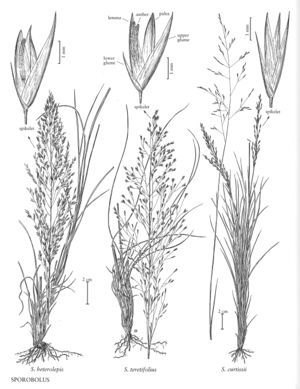Sporobolus heterolepis
Plants perennial; cespitose, not rhizomatous. Culms 30-80 (90) cm. Sheaths dull and fibrous basally, glabrous or sparcely pilose below, hairs to 4 mm, contorted; ligules 0.1-0.3 mm; blades 7-31 cm long, 1.2-2.5mm wide, flat to folded, glabrous abaxially, scabridulous adaxially, margins scabrous. Panicles 5-22 (25) cm long, (0.6) 1-11 cm wide, open to somewhat contracted, longer than wide, narrowly pyramidal, not diffuse; lower nodes with 1-2 (3) branches; primary branches 0.6-8 (11) cm, appressed or spreading to 70° from the rachis, not capillary, without spikelets on the lower 1/3, pedicels 0.8-6 mm, appressed, occasionally spreading. Spikelets 3-6 mm, plumbeous. Glumes unequal, lanceolate, membranous; lower glumes (1.2) 1.8-4.5 mm; upper glumes 2.4-6 mm, at least 2/3 as long as the florets, occasionally 3-veined; lemmas (2.7) 3-4.3 mm, ovate, membranous, glabrous, acute; paleas 3.1-4.5 mm, slightly longer than the lemmas, ovate, membranous, glabrous; anthers 1.7-3 mm, yellowish to purplish. Fruits 1.4-2.1 mm, pyriform to globose, indurate, without a loose pericarp, smooth, shining, light-brown. 2n = 72.
Distribution
Wis., Man., Ont., Que., Sask., Wyo., N.Mex., N.C., N.Y., Pa., Va., Colo., Kans., N.Dak., Nebr., Okla., S.Dak., Ark., Ill., Ga., Ind., Iowa, Conn., Md., Mass., Ohio, Mo., Minn., Mich., Mont., Ky.
Discussion
Sporobolus heterolepis grows at elevations of 40-2250 m, in lowland and upland prairies, along the borders of woods, roadsides, and swamps, and in north-facing swales. It is associated with many plant communities, and is also available commercially as an ornamental. It is restricted to the Flora region.
Selected References
None.
Lower Taxa
"decumbent" is not a number.
